Ever wonder what it is like to live in a different time? For two years while we were back in Virginia, my husband and I were members of the 7th Virginia Regiment, interpreting the life and times of Virginians during the Revolutionary War era.
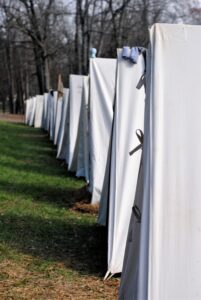
We arrive late afternoon on Friday in our horse-drawn wagon (aka my Jeep Cherokee) and seek the members of our unit, the 7th Virginia Regiment. These days, with work commitments, we’re not able to march in together along the dusty road as in the past. But greet each other with hugs and claps on the back as each member arrives.

The car is emptied, and we line our tent along strings set to keep each one aligned on the previous. The small gap left between them makes for rather cozy sleeping quarters. This accommodation consists of a length of canvas stretched over a pole, creating an inverted V.
After sleeping on the ground wrapped in wool blankets the first time, we now put down a padding of straw. However, I am allergic to straw… so Dave crawls in, spreads out a nice thick layer, and covers it with a tarp from Lowes. You know, those blue ones? Next, he places a canvas floor covering on top, concealing the bright blue from public view. A little straw scattered outside prevents chilling drafts from sneaking beneath the sides.
Once our ‘walls’ are up, we stow the wooden boxes containing our clothing and gear and join everyone around the campfire. Friday sometimes means sneaking off to a local establishment for camaraderie. Other times, our campfire provides all we need. The best times are enjoyed in the taverns of Colonial Williamsburg, in period dress, of course.
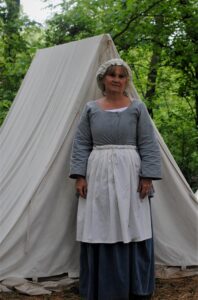
Most events are reenactments of Revolutionary War battles occurring on or near the site of a historical event. Others may be for public education. Either way, we are up early on Saturday morning, stirring up the embers. The fire is lit, and coffee, packed into small linen bags, brews on the brazier. Slowly, the aroma draws members from their beds.
Erected beside the fire pit sits our pavilion, with our table for prepping food and a seating area. At one end is the Tardis, our time machine, where all modern items are stowed. Usually, this means coolers full of food. We are in the 21st century, after all.
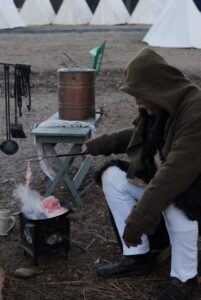
While the men fry the bacon, Annette, my partner in crime, and I lay out hard-boiled eggs and bread and jam for everyone to break their fast. This would have been a traditional start to the day for many colonists. Men stuck eggs and hunks of bread in a pocket while they went about their morning chores, returning later for a more substantial meal.
After breakfast, the men, and a few women of the 7th, prepare for the day’s battle, breaking into groups of militia, rifle company, or cannon crew. Annette is in charge of the distaff, or the camp followers. This group comprised the soldiers’ wives, along with physicians and various tradespeople. The term camp follower has taken on a different connotation over time, but in this era, it meant the support staff and the wives of those who had no other option but to follow along and survive as best they could.
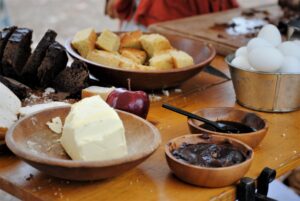
George Washington expressed his displeasure at these additional people but realized that the men remained with him when they knew their families were safe. Many of these women had no relatives to go to in town and might not be safe if their neighbors remained loyal to the Crown. Washington allowed them to stay at half rations, and many found employment doing laundry or cooking for officers. If a woman’s husband was killed, she had seven days to find a new one, or she was released where she was. I imagine many kept an eye on the future possibilities.
As members of the distaff, we set up exhibits of colonial life; the year, the season, and the duration of the war were taken into consideration. These factors played a significant role in what was available. Food was eaten seasonally, and rations became increasingly difficult to obtain as the war drug on. Initially, a soldier’s rations consisted of a pound of meat and a pound of bread or flour per day, three pounds of beans or peas a week, and a quart of beer or cider per day. A pint of milk was allotted each day but rarely received. A soldier hoped for bread, as a pound of flour had to be mixed with water without yeast forming a flat griddlecake. This became more common as the war raged.
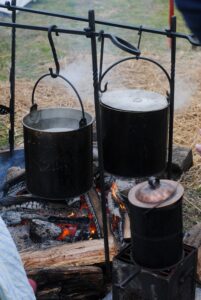
While Annette and I displayed those rations for the public, we cooked things that a typical family on the frontier at the time would have at home, and we explain the difference to interested onlookers. Vegetables grown in the garden were boiled, and whatever meat was available was thrown into the pot, which was moved on and off the fire over several days as they added to it. While we sometimes used Saturday night’s leftovers to start the pot for Sunday, the old saying “Pease porridge hot, pease porridge cold, pease porridge in the pot, nine days old” would never be acceptable today!
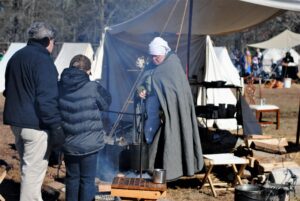
It was fun to research what was available and recreate the foods they ate. Herbs were essential, not only medicinally, but any woman worth her salt knew how to add flavor to her food. So while today we may think boiled food doesn’t sound very appealing, it surprisingly had flavor.
Between events, I hand-sewed clothing items and researched the life of the time, from spinning, weaving, and laundry to growing food in the garden, making medicines, and baking bread. A special treat for me was to be a docent at Ker Place, a colonial home on the Eastern Shore of Virginia. I shared information from those tours with the public at Rev War events and vice versa. General John Cropper, who served under George Washington, grew up nearby and ran away to join the 7th Virginia Regiment, so he holds a special place in my heart. Today, his bed sits in the bedroom of Ker Place in Onancock.

Whether it was 100 degrees at Brandywine or 17 degrees at Cowpens, it was great fun, and I hope to continue with it when we return. What could be better than stepping out of your tent in the morning onto the lawn of Mount Vernon overlooking the Potomac River? Or an early morning wander through Thomas Jefferson’s gardens at Monticello?
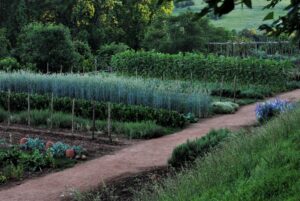
Do you ever wish to experience life in a different time?
